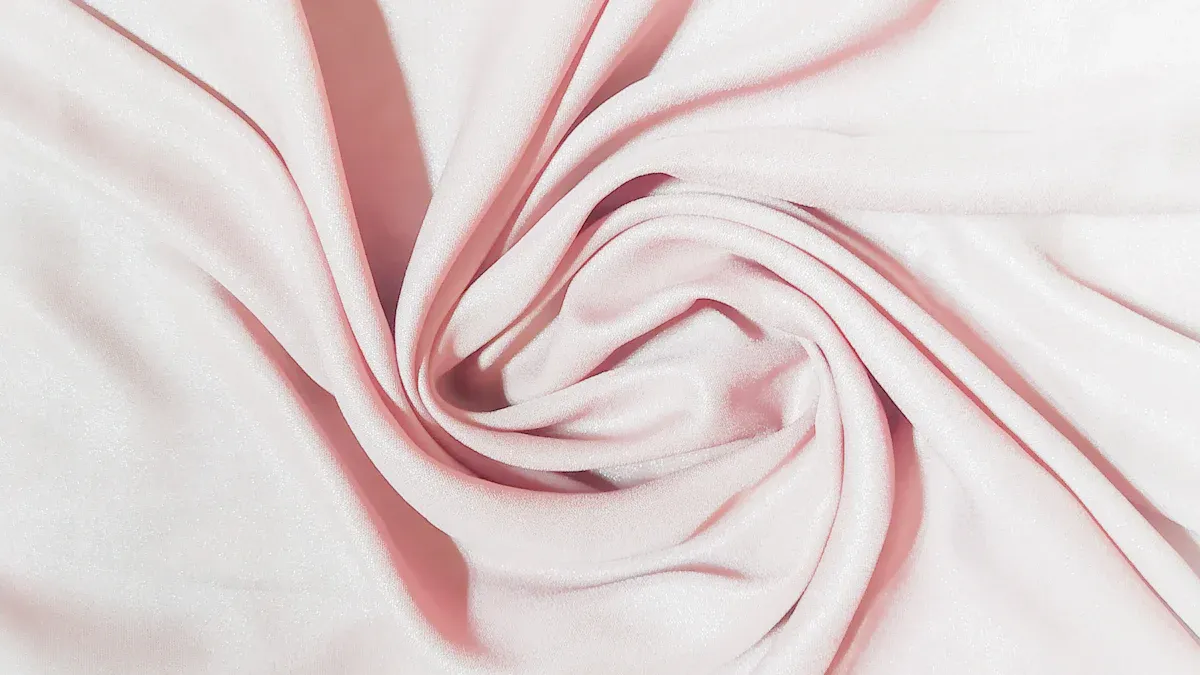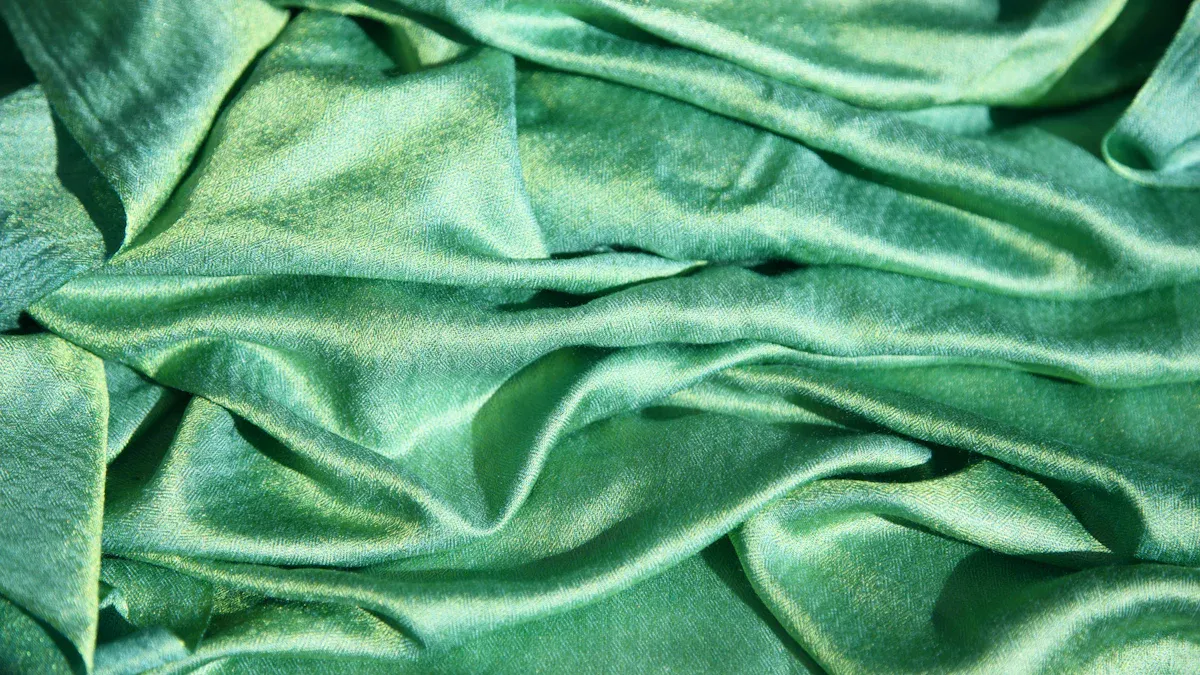
Viscose fabric is a special material made from plant fibers. It usually comes from wood pulp. It feels soft and lets air pass through, so it’s popular in clothing. The global viscose market might grow from $15.55 billion in 2023 to $26.55 billion by 2032. This shows more people and brands like it. Many choose viscose because it is soft and kind to the skin. It’s a good choice for people with sensitive skin.
Key Takeaways
- Viscose fabric is soft, airy, and made from plants. It is great for comfy clothes.
- It soaks up sweat well, keeping skin dry and cool. This makes it good for sensitive skin and hot days.
- Viscose is cheap and stylish but needs gentle washing. This stops it from shrinking or wrinkling.
- Making viscose uses chemicals and lots of water. This causes worries about the environment, even though it’s plant-based.
- Viscose is useful for many things like clothes and home items. It can mix with other fabrics to improve its features.
What is viscose fabric?

Definition and composition
Viscose fabric is partly natural and partly man-made. It comes from cellulose, a fiber found in plants. Another name for it is rayon. To make it, manufacturers use wood from trees like bamboo, spruce, or eucalyptus. They mix the wood pulp with chemicals to turn it into a thick liquid. This liquid is then spun into threads.
This fabric is known for being soft, airy, and useful for many things. It feels gentle on the skin, which is why it’s popular in clothing. From light summer dresses to warm scarves, viscose fabric is both comfy and stylish.
Tip: Want a fabric that feels like cotton but looks like silk? Try viscose fabric!
How is viscose fabric made?
Making viscose fabric involves many steps:
- Wood pulp is used to get cellulose.
- The cellulose is mixed with a chemical called caustic soda.
- The extra liquid is squeezed out using rollers.
- The pressed sheets are broken into tiny pieces called “white crumb.”
- These pieces are left in the air to age.
- A chemical called carbon disulfide is added, making “yellow crumb.”
- The yellow crumb is mixed with caustic soda again to form viscose.
- The viscose is left to sit for a while.
- It is cleaned to remove dirt and air bubbles.
- The liquid is pushed through small holes to make thin threads.
- These threads are dipped in acid to harden into rayon fibers.
- The fibers are stretched to make them stronger.
- They are washed to take out leftover chemicals.
- Finally, the fibers are cut if shorter lengths are needed.
This detailed process changes wood pulp into soft, breathable fabric. Even though chemicals are used, the base material is natural. This gives viscose its mix of comfort and elegance.
Is viscose fabric skin-friendly?
Skin-friendliness and comfort
Viscose fabric is very soft and comfy to wear. It is light and lets air pass through easily. This keeps you cool on hot days. It’s perfect for summer clothes or sportswear. The fabric soaks up sweat and body oils well. This helps your skin stay dry and fresh all day.
Its softness makes it even more loved by many. It feels smooth and gentle on the skin. You can wear it at home or outside comfortably. It gives a fancy feel but is still practical. The airflow it provides keeps your body cool, even when you’re active.
Tip: Want a fabric that’s comfy and stylish? Pick viscose fabric for your outfits!
Suitability for sensitive skin
Viscose fabric is a good pick for sensitive skin. It is gentle and less likely to cause irritation. Experts say it’s safe for people with delicate skin. Its soft texture reduces rubbing, which helps avoid redness or pain.
The fabric also lets your skin breathe well. This stops sweat from building up and causing problems. It absorbs moisture, keeping your skin dry and comfy. These features make viscose a great choice for healthy skin.
Note: Always read the care label on viscose clothes. Make sure they don’t have extra chemicals that could bother sensitive skin.
Advantages and disadvantages of viscose fabric
Benefits of viscose fabric
Viscose fabric has many good points that make it popular:
- Softness and Comfort: It feels smooth and gentle, great for sensitive skin.
- Breathability: Air flows through it, keeping you cool in hot weather.
- Moisture Absorption: It soaks up sweat, helping you stay dry all day.
- Versatility: It’s lightweight and drapes well, perfect for clothes or home items.
- Affordability: It feels fancy but costs less than silk or expensive fabrics.
- Eco-Friendliness: Made from natural cellulose, it’s better than synthetic fabrics.
Fun Fact: Viscose feels like cotton but shines like silk. It’s a top pick for stylish, comfy outfits!
Drawbacks of viscose fabric
Even with its perks, viscose fabric has some downsides:
- Prone to Wrinkling: It wrinkles easily and needs ironing to look neat.
- Shrinkage Risk: Washing it wrong can make it shrink, so handle with care.
- Flammability: It catches fire faster than synthetic fabrics, so be cautious.
- Environmental Concerns: Making it uses harmful chemicals and lots of water. One ton of viscose needs 30 tons of water.
- Maintenance Challenges: It often needs dry cleaning or gentle washing. It can stain or lose color easily.
| Drawback | Description |
|---|---|
| Chemically Intensive Process | Harmful chemicals are used, which can hurt people and nature. |
| High Water Consumption | Making viscose uses a lot of water, which isn’t eco-friendly. |
| Deforestation | Cutting trees for wood pulp harms forests and animals. |
| Maintenance Issues | Needs special care to avoid shrinking, wrinkling, or staining. |
Note: Always read the care label on viscose clothes to keep them in good shape.
How does viscose fabric compare to other fabrics?
Viscose vs. cotton
Viscose and cotton have things in common but are also different. Both come from natural sources. Cotton is from the cotton plant, while viscose is made using wood pulp. Making viscose uses more chemicals than cotton.
Viscose feels smoother and silkier compared to cotton. It’s great for clothes like dresses or blouses that need to drape well. Cotton feels more casual and works better for t-shirts or jeans.
Both fabrics let air pass through, keeping you cool. Cotton absorbs sweat better, making it good for hot weather. Viscose can soak up moisture too but gets weaker when wet.
Tip: Pick cotton for strength and easy care. Choose viscose for a fancy and soft feel.
| Feature | Viscose | Cotton |
|---|---|---|
| Softness | Smooth and silky | Soft but less silky |
| Durability | Weaker when wet | Strong and long-lasting |
| Care | Needs gentle handling | Easy to wash and maintain |
Viscose vs. polyester
Viscose and polyester are very different fabrics. Viscose is partly natural, while polyester is fully synthetic and made from petroleum. This makes them feel and act differently.
Viscose feels soft and natural, like silk or cotton. Polyester feels less breathable and can trap heat. If you want comfort, viscose is better. Polyester is stronger and doesn’t wrinkle or shrink, so it’s easier to care for.
Polyester dries faster, which is good for sportswear. But it doesn’t soak up sweat well, so you might feel sticky. Viscose absorbs sweat better but needs careful washing.
Note: Polyester is perfect for easy-care clothes. Viscose is softer and more breathable for comfort.
| Feature | Viscose | Polyester |
|---|---|---|
| Feel | Soft and breathable | Less breathable, synthetic |
| Durability | Prone to shrinking/wrinkling | Strong and wrinkle-resistant |
| Moisture Handling | Absorbs moisture well | Dries quickly but traps sweat |
Applications and best uses of viscose fabric
Common uses in fashion
Viscose fabric is widely used in making clothes. Its soft feel and smooth drape make it perfect for stylish outfits. You’ll see it in dresses, skirts, and blouses. It’s light and comfy, adding both style and ease. Activewear and loungewear often use viscose because it absorbs sweat and lets skin breathe.
This fabric looks like silk but costs much less. Designers use it for fancy gowns, scarves, and ties. It’s also great for casual clothes like t-shirts and summer wear. If you want a mix of comfort and style, viscose is a great pick.
| Application Area | Description |
|---|---|
| Automotive Industry | Used for car seats and linings because it’s comfy and stylish. |
| Home Textiles | Perfect for curtains and bed sheets, offering beauty and function. |
| Specialty Applications | Blended with other materials for unique uses in advanced products. |
Tip: Want soft, fancy clothes without spending too much? Try viscose!
Other applications in textiles
Viscose isn’t just for clothes. Its special features make it useful in many fields. In healthcare, it’s used for bandages and wipes because it’s soft and absorbs well. It’s also eco-friendly, making it great for disposable items.
In technical uses, viscose works in filters to clean liquids and air. It’s also used in tire cords to make tires stronger and stretchier. At home, viscose is found in curtains and bed linens, combining beauty with usefulness.
- Viscose filament is used in clothes, home items, and technical products.
- It’s chosen for hygiene items because it absorbs well and breaks down naturally.
- Its softness and strength make it great for wipes and cleaning products.
Viscose is also used in filters and special blends for unique purposes. Whether for fashion or technical needs, this fabric is valuable in many areas.
Note: Viscose is eco-friendly, making it a smart choice for disposable and hygiene products.
Viscose fabric is soft, light, and great for many uses. It feels smooth and lets air flow, making it comfy. It also absorbs sweat well, keeping you cool and dry.
But there are some downsides to think about. Making viscose harms the environment by using lots of water and chemicals. Plus, it needs careful washing to stay in good shape.
| Key Features | Description |
|---|---|
| Soft Texture | Feels smooth like silk, giving a fancy feel. |
| Breathability | Lets air pass through, perfect for hot days. |
| Moisture Absorption | Soaks up sweat, keeping skin fresh and dry. |
| Versatility | Works for clothes and home items like curtains. |
| Care Considerations | Needs gentle care to avoid shrinking or wrinkling. |
Even with its flaws, viscose is loved for being affordable and fancy. If cared for properly, it’s stylish, comfy, and useful for many things.
FAQ
How is viscose fabric unique from other fabrics?
Viscose fabric is soft, silky, and breathable. It feels smoother than cotton and more natural than polyester. Its flowy look makes it great for stylish clothes. But it needs extra care compared to other fabrics.
Can viscose fabric be washed at home?
Yes, but wash it carefully. Use cold water and gentle soap. Don’t twist or wring it. Lay it flat to dry to avoid shrinking. Always read the care label for proper instructions.
Tip: Washing by hand is the safest way for viscose clothes!
Is viscose fabric good for the environment?
Viscose is partly eco-friendly since it’s made from natural cellulose. But making it uses chemicals and lots of water, which can harm nature. Eco-friendly options like lyocell are better for the planet.
Does viscose fabric shrink often?
Yes, viscose can shrink if not washed properly. Hot water, high heat, or rough handling can ruin its shape. Wash it gently and skip the dryer to keep it safe.
Can viscose fabric be worn in all seasons?
Yes, viscose works well in every season. It keeps you cool in summer and warm when layered in winter. Its versatility makes it a great choice all year.
Note: Mix viscose with other fabrics for extra warmth in winter!
